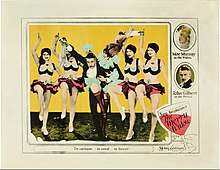The Merry Widow (1925 film)
The Merry Widow is a 1925 American silent romantic drama/black comedy film directed and written by Erich von Stroheim. Released by Metro-Goldwyn-Mayer, the film stars Mae Murray, John Gilbert, Roy D'Arcy, and Tully Marshall,[2][3] with pre-fame uncredited appearances by Joan Crawford and Clark Gable.
| The Merry Widow | |
|---|---|
.jpg) | |
| Directed by | Erich von Stroheim |
| Produced by | Erich von Stroheim Irving Thalberg (uncredited) |
| Written by | Erich von Stroheim Benjamin Glazer |
| Based on | The Merry Widow by Franz Lehár Victor Léon (libretto) Leo Stein (libretto) |
| Starring | Mae Murray John Gilbert Roy D'Arcy Tully Marshall |
| Music by | William Axt (uncredited) David Mendoza (uncredited) Franz Lehár (non-original music) |
| Cinematography | Oliver T. Marsh William H. Daniels |
| Edited by | Frank E. Hull Margaret Booth (uncredited) |
| Distributed by | Metro-Goldwyn-Mayer |
Release date | August 26, 1925 |
Running time | 137 minutes |
| Country | United States |
| Language | Silent (English intertitles) |
| Budget | $592,000[1] |
| Box office | $1.9 million[1] |
The film is based on the Franz Lehár's operetta of the same name, and was its second film adaptation, the first being a 1918 Hungarian film directed by Michael Curtiz.
While a print of the film still survives, the end sequence shot in two-tone Technicolor is now lost.[4]
Plot
Prince Danilo falls in love with dancer Sally O'Hara. His uncle, King Nikita I of Monteblanco, forbids the marriage because she is a commoner. Thinking she has been jilted by her prince, Sally marries the old and lecherous Baron Sadoja, whose wealth has kept the kingdom afloat. When he dies suddenly, Sally must be wooed all over again by Danilo.
Cast
- Mae Murray as Sally O'Hara
- John Gilbert as Prince Danilo Petrovich
- Roy D'Arcy as Crown Prince Mirko
- Josephine Crowell as Queen Milena
- George Fawcett as King Nikita I
- Tully Marshall as Baron Sixtus Sadoja
- Edward Connelly as Baron Popoff (ambassador)
Uncredited
Selected cast that were uncredited:
- Helen Howard Beaumont as Chorus girl
- Gertrude Bennett as Hard-Boiled Virginia
- Bernard Berger as Boy
- Sidney Bracey as Danilo's footman
- Estelle Clark as French barber
- Albert Conti as Danilo's adjutant
- D'Arcy Corrigan as Horatio
- Joan Crawford as Extra
- Xavier Cugat as Orchestra leader
- Anielka Elter as Blindfolded musician
- Dale Fuller as Sadoja's chambermaid
- Clark Gable as Ballroom dancing extra
- Edna Tichenor as Dopey Marie
- Zalla Zarana as Frenchie Christine
Production

The film was shot over twelve weeks with a budget of $592,000. Filming was tense as Mae Murray and the film's director, Erich von Stroheim, did not get on well. After production, Metro-Goldwyn-Mayer decided it could no longer work with the director after he added sexually explicit scenes and changed the operetta's libretto.[5]
Reception
Upon its release, the film was both a critical and box office success. Critics praised Murray's dramatic skills while also noting that von Stroheim had "made an actress out of Miss Murray".[6] The film made a profit of $758,000.[1][7]
Other adaptations
The Merry Widow was adapted for the screen in 1934, 1952, 1962, and 1994.
See also
References
- The Eddie Mannix Ledger, Los Angeles: Margaret Herrick Library, Center for Motion Picture Study.
- Variety film review; September 2, 1925, page 36.
- Harrison's Reports film review; September 12, 1925, page 147.
- "Cinema", TIME, September 14, 1925
- Sullivan, Chris (February 2019). "Erich Von Stroheim". Chap. Spring 2019: 23–27.
- Ankerich, Michael G. (2012). Mae Murray: The Girl with the Bee-Stung Lips. University Press of Kentucky. pp. 166–168. ISBN 0-813-14038-2.
- Scott Eyman, Lion of Hollywood: The Life and Legend of Louis B. Mayer, Robson, 2005 p 99
External links
| Wikimedia Commons has media related to The Merry Widow (1925 film). |
- The Merry Widow on IMDb
- Synopsis at AllMovie
- Fritzi Kramer, The Merry Widow, a Silent Review at moviessilently.com, with stills